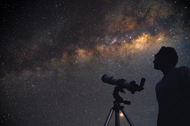Oct1 Fun Holiday – International Observe the Moon Night
International Observe the Moon Night (InOMN) is an annual celebration of our closest celestial neighbor - the Moon. The date of the unofficial holiday changes every year.

Camp out to see the Moon on International Observe the Moon Night.
©iStockphoto.com/tolstnev
InOMN is led by scientists, astronomers, teachers, policy makers and science and astronomy organizations around the world and is sponsored by NASA's Lunar Reconnaissance Orbiter, NASA's Solar System Exploration Research Virtual Institute (SSERVI), and the Lunar and Planetary Institute. The holiday is an attempt to spread scientific information about the Moon among the public, and encourage people to learn more about Earth's only natural satellite through observing it and by interacting with lunar experts.
Mysterious Origins
Thought to be between 4 to 4.5 billion years old, the Moon's birth is a bit of mystery. The current prevailing scientific theory of its creation suggests that it was formed as a result of a collision between the Earth and another planet, the size of Mars.
The second brightest celestial objects in our sky, next only to the Sun, the Moon has been instrumental in creating the world as we know it today. Without the Moon, The Earth and life would be very different. The nights would be much darker, tides would be fewer and smaller, and the Earth's axial tilt would be less stable. And we would have no eclipse – solar or lunar.
Capturing Imaginations
Throughout history, the Moon has captured the imagination of people around the world. Since antiquity, astronomers, philosophers, spiritualists and religious leaders have all tried to understand and explain the mechanism of day and night, the Moon's phases and lunar eclipses. In addition to helping keep time, the Moon was worshipped as a deity in many ancient cultures. Even today, lunar phenomena such as Blue Moons, Supermoons, Micro Full Moons and Black Moons are popular astronomical events that gather extensive public interest.
Basis of Calendars
In many parts of the world, lunar or lunisolar calendars are still used to determine dates of cultural and religious holidays. Lunar calendars, such as the Islamic calendar, are strictly based on the phases of the Moon. Because the lunar year (354.35 days) is shorter than the solar or tropical year (365.25) by about 11 days, lunar calendars tend to be out of sync with solar calendars such as the Gregorian calendar and the Julian calendar.
Lunisolar calendars, such as the Chinese calendar or Hindu calendars used in many parts of India, use both moon phases and the solar year to overcome this drift.
How to Celebrate?
This one's simple. Just step out and look up the sky to behold the wonder of the Moon. Here are some more ways to spend this celestial holiday:
- Find an Observe the Moon night event close to you and attend it.
- Join other astronomy and lunar enthusiasts and spend the evening and night observing the Moon.
- Spend the day learning more about the Moon and how it affects life on Earth.
Did You Know...
...that a person's weight on the Moon is about 1/6 of his or her weight on Earth?
International Observe the Moon Night Observances
| Fun Holiday: International Observe the Moon Night Observances | |||
|---|---|---|---|
| Year | Weekday | Date | Name |
| 2020 | Sat | Sep 26 | International Observe the Moon Night |
| 2021 | Sat | Oct 16 | International Observe the Moon Night |
| 2022 | Sat | Oct 1 | International Observe the Moon Night |



